1873 Vienna World's Fair
The 1873 Vienna World's Fair (German: Weltausstellung 1873 Wien) was the large world exposition that was held in 1873 in the Austria-Hungarian capital Vienna. Its motto was "Culture and Education" (Kultur und Erziehung).
| 1873 Vienna | |
|---|---|
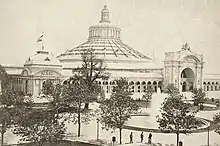 The Rotunda, the centre of the exhibition | |
| Overview | |
| BIE-class | Universal exposition |
| Category | Historical Expo |
| Name | Weltausstellung |
| Motto | Kultur und Erziehung (English: Culture and Education) |
| Building | Rotunda |
| Area | 233 Ha |
| Visitors | 7,255,000 |
| Location | |
| Country | Austria-Hungary |
| City | Vienna |
| Venue | Prater |
| Coordinates | 48°12′58″N 16°23′44″E |
| Timeline | |
| Opening | 1 May 1873 |
| Closure | 31 October 1873 |
| Universal expositions | |
| Previous | Exposition Universelle (1867) in Paris |
| Next | Centennial Exposition in Philadelphia |
History
As well as being a chance to showcase Austro-Hungarian industry and culture, the World's Fair in Vienna commemorated Franz Joseph I's 25th year as emperor.[1] The main grounds were in the Prater, a park near the Danube River, and preparations cost £23.4 million.[2] It lasted from May 1st to November 2nd, hosting about 7,225,000 visitors.[2]
Facilities
There were almost 26,000 exhibitors[3] housed in different buildings that were erected for this exposition, including the Rotunda (Rotunde), a large circular building in the great park of Prater designed by the Scottish engineer John Scott Russell. (The fair Rotunda was destroyed by fire on 17 September 1937.)
Russian pavilion
The Russian pavilion had a naval section designed by Viktor Hartmann. Exhibits included models of the Port of Rijeka[4] and the Illés Relief model of Jerusalem.[5]
Japanese pavilion
The Japanese exhibition at the fair was the product of years of preparation. The empire had received its invitation in 1871, close on the heels of the Meiji Restoration, and a government bureau was established to produce an appropriate response. Shigenobu Okuma, Tsunetami Sano, and its other officials were keen to use the event to raise the international standing of Japanese manufactures and boost exports. 24 engineers were also sent with its delegation to study cutting-edge Western engineering at the fair for use in Japanese industry.[2] Art and cultural relics at the exhibit were verified by the Jinshin Survey, a months-long inspection tour of various imperial, noble, and temple holdings around the country.[6] The most important products of each province were listed and two specimens of each were collected, one for display in Vienna and the other for preservation and display within Japan.[2] Large-scale preparatory exhibitions with this second set of objects were conducted within Japan at the Tokyo Kaisei School (today the University of Tokyo) in 1871 and at the capital's Confucian Temple in 1872; they eventually formed the core collection of the institution that became the Tokyo National Museum.[1]
41 Japanese officials and government interpreters, as well as 6 Europeans in Japanese employ, came to Vienna to oversee the pavilion and the fair's cultural events. 25 craftsmen and gardeners created the main pavilion, as well as a full Japanese garden with shrine and a model of the former pagoda at Tokyo's imperial temple.[2] Apart from the collection of regional objects, which focused on ceramics, cloisonné wares, lacquerware, and textiles, the displays also included the female golden shachi from Nagoya Castle and a papier-maché copy of the Kamakura Buddha.[2] The year after the fair, Sano compiled a report on it which ran to 96 volumes divided into 16 parts, including a strong plea for the creation of a museum on western lines in the Japanese capital; the government further began hosting national industrial exhibitions at Ueno Park in 1877.[2]
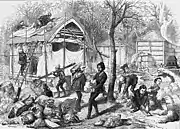 A Western engraving of the Japanese craftsmen constructing the pavilion and garden
A Western engraving of the Japanese craftsmen constructing the pavilion and garden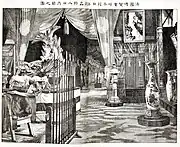 The foyer of the Japanese pavilion, from the Japanese report on the fair compiled under Tsunetami Sano
The foyer of the Japanese pavilion, from the Japanese report on the fair compiled under Tsunetami Sano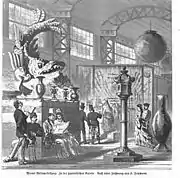 The interior of the pavilion, including the golden shachi, from the Illustrated Times (Illustrirte Zeitung)
The interior of the pavilion, including the golden shachi, from the Illustrated Times (Illustrirte Zeitung)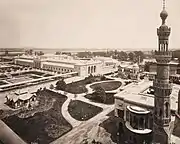 Part of the Japanese display, as seen from one of the Ottoman minarets
Part of the Japanese display, as seen from one of the Ottoman minarets
Ottoman pavilion
Osman Hamdi Bey, an archaeologist and painter, was chosen by the Ottoman government as commissary of the empire's exhibits in Vienna. He organized the Ottoman pavilion with Victor Marie de Launay, a French-born Ottoman official and archivist, who had written the catalogue for the Ottoman Empire's exhibition at the 1867 Paris World's Fair.[7] The Ottoman pavilion, located near the Egyptian pavilion (which had its own pavilion despite being a territory of the Ottoman Empire),[8] in the park outside the Rotunde, included small replicas of notable Ottoman buildings and models of vernacular architecture: a replica of the Sultan Ahmed Fountain in the Topkapı Palace, a model Istanbul residence, a representative Turkish bath, a cafe, and a bazaar.[9] The 1873 Ottoman pavilion was more prominent than its pavilion in 1867. The Vienna exhibition set off Western nations' pavilions against Eastern pavilions, with the host, the Austro-Hungarian Empire, setting itself at the juncture between East and West.[8] A report by the Ottoman commission for the exhibition expressed a goal of inspiring with their display "a serious interest [in the Ottoman Empire] on the part of the industrialists, traders, artists, and scholars of other nations...."[8]
The Ottoman pavilion included a gallery of mannequins wearing the traditional costumes of many of the varied ethnic groups of the Ottoman Empire. To supplement the cases of costumes, Osman Hamdi and de Launay created a photographic book of Ottoman costumes, the Elbise-i 'Osmaniyye (Les costumes populaires de la Turquie), with photographs by Pascal Sébah. The photographic plates of the Elbise depicted traditional Ottoman costumes, commissioned from artisans working in the administrative divisions (vilayets) of the Empire, worn by men, women, and children who resembled the various ethnic and religious types of the empire, though the models were all found in Istanbul. The photographs are accompanied by texts describing the costumes in detail and commenting on the rituals and habits of the regions and ethnic groups in question.[8]
Italian pavilion
Professor Lodovico Brunetti of Padua, Italy first displayed cremated ashes at the exhibition. He showed a model of the crematory, one of the first modern ones. He exhibited it with a sign reading, "Vermibus erepti, puro consummimur igni," in english, "Saved from the worms, we are consumed by the flames."[10]
Gallery
 Main entrance to the fair with the Rotunda behind
Main entrance to the fair with the Rotunda behind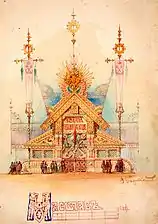 Naval section of the Russian pavilion
Naval section of the Russian pavilion The Illés Relief
The Illés Relief Swedish folk costumes displayed at the exposition
Swedish folk costumes displayed at the exposition
Impact on Vienna
The exhibition led to an intensive building activity in the years before. The new train station to Germany, the Nordwestbahnhof, was completed just prior to the fair.
References
Citations
- TNM (2019), Yushima Seido Exposition.
- TNM (2019), The World's Fair in Viena: The Origin of the Japanese Modern Museum.
- Lowe, Charles (1892). Four national exhibitions in London and their organiser. With portraits and illustrations (1892). London, T. F. Unwin. p. 28. Retrieved April 5, 2012.
- "PATCHing the city 09". City of Rijeka. 2009. p. 6. Archived from the original (PDF) on March 19, 2012. Retrieved November 27, 2013.
- "Tower of David Museum of the History of Jerusalem | Model of Jerusalem in the 19th Century". Towerofdavid.org.il. Archived from the original on December 3, 2013. Retrieved November 27, 2013.
- TNM (2019), The Jinshin Survey: Research of Cultural Properties.
- Trencsényi, Balász; Kopečk, Michal (2007). "Osman Hamdi Bey and Victor Marie de Launay: The Popular Costumes of Turkey in 1873". Discourses of Collective Identity in Central and Southeast Europe (1770–1945). National Romanticism: Formation of National Movements. II. Budapest; New York: Central European University Press. pp. 174–180.
- Ersoy, Ahmet (2003). "A Sartorial Tribute to Late Tanzimat Ottomanism: The Elbise-i 'Osmaniyye Album". Muqarnas. 20: 187–207. JSTOR 1523332.
- Çelik, Zeynep (1992). "Islamic Quarters in Western Cities: Universal Exposition of 1873, Vienna". Displaying the Orient: Architecture of Islam at Nineteenth-Century World's Fairs. Berkeley, Los Angeles, Oxford: University of California Press. ISBN 0520074947.
- Prothero, Stephen (2001). Purified By Fire: A History of Cremation in Ameria. Los Angeles, California: University of California Press. p. 9. ISBN 0-520-20816-1.
Bibliography
- Official site, Tokyo National Museum, 2019. (in English)
External links
- Official website of the BIE
 Media related to Expo 1873 at Wikimedia Commons
Media related to Expo 1873 at Wikimedia Commons- The Rotunda of the 1873 Vienna International Exhibition
- Images from the exhibition
- 1873 Vienna (BIE World Expo) - approximately 90 links